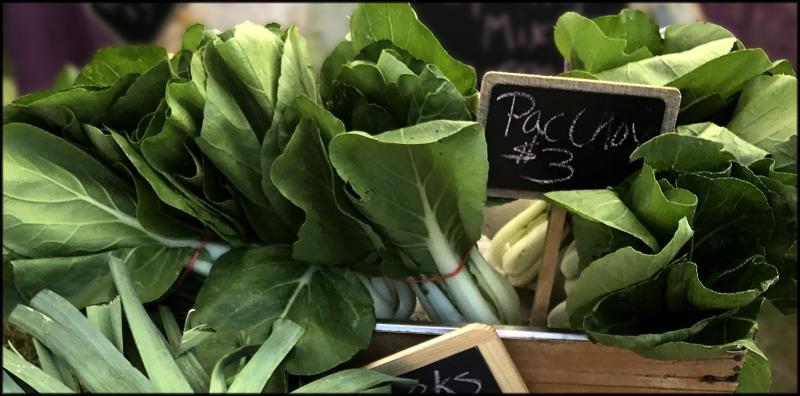Here are tips to preserve your harvest
On a recent social media post, my friend Sarah Pinsker lamented her abundant supply of pac choi and asked for suggestions about her (uncooked) leftovers. Sometimes spelled bok choy and called horse’s ear in the UK, this crisp, leafy member of the cabbage family grows in clusters of white, slightly ribbed leaf stalks with oval green leaves (see photo).
The flavor of pac choi is something between a very mild cabbage and tender spinach.
In early summer, many markets and CSAs offer bundles of small, baby-sized heads, well-suited for salads and stir-fries. As a traditional Asian ingredient, most recipes for pac choi feature Oriental flavors such as ginger and soy. Since Sarah had her fill of cooked pac choi, we told her to freeze the remainders for a future meal. But, how do you freeze leafy greens without creating a mushy mess? Although this method won’t keep it as crisp as when you brought it home from the market, it will remain solid enough for soups and stir fries.
The key is to freeze the pieces separately so you don’t end up with a large block of pac choi ice. After gently cleaning the leaves with a damp paper towel, place the pac choi on a cutting board and roughly chop the stems and leaves, then spread them into a single layer on a rimmed baking sheet lined with wax paper. Place the baking sheet in the freezer for about 45 minutes. Transfer the frozen pieces to a zip-top plastic bag and press out all the air before sealing the bag. Keep it in the freezer until you’re ready to add the subtle flavors of pac choi to your next recipe.
This technique works for all sorts of produce from the summer markets - fruits, greens, tomatoes, beans, peppers. I find that fruits and greens shouldn’t be cooked first, while blanching the larger vegetables is a good idea. For zucchini and summer squash, cut them into large cubes and blanch for just one minute in a pot of boiling water. Drain and transfer the pieces immediately to an ice bath. Again, you don’t want to place them in a bag right away, but spread them in a single layer to freeze into individual pieces. Once they’re solid, transfer the chunks to a zip-top bag and place in the freezer.
Another approach to preserving your harvest does include cooking and is an ideal way to handle onions threatening to mold: caramelizing. Thinly slice onions into rounds and sauté in a mixture of olive oil and butter over very low heat until brown but not burned. Once the onions have cooled, transfer them into small zip-top bags and then to the freezer. One advantage to these freezing methods is having almost-as-good-as-fresh ingredients prepped and ready to throw into the cooking pot. You don’t need to thaw them first, and you’ll add the essence of summer flavors to your dishes or rich onion essence to your next batch of soup, stew, gravy or sauce.
The final suggestion is to marinate roasted or grilled vegetables such as zucchini, eggplant, mushrooms, peppers and tomatoes. After they’re cooked, toss them in a large bowl with olive oil, vinegar, salt, pepper, herbs, garlic cloves, lemon zest and red pepper flakes. Transfer the mixture to a sealed container, making sure the vegetables remain submerged. This is best used within a week’s time.
I’ve included pac choi recipes that will work well with either fresh or frozen leaves and should help Sarah with her bumper crop.
Sesame Pac Choi
6 small heads pac choi
1 garlic clove
1 T peanut oil
3 t toasted sesame oil (divided)
1/4 t red pepper flakes
1 t sesame seeds
salt, to taste
Cut the base from the pac choi to separate the leaves. Rinse and spin dry; coarsely chop the leaves. Peel and finely chop the garlic; set aside. Heat the peanut oil in a large skillet (or wok) over medium-high.
Add pac choi and garlic; toss to coat. Stir in red pepper flakes and 2 t sesame oil. Cover and reduce heat to low. Cook, shaking the pan, just until tender, about 2 to 3 minutes. Remove from heat; stir in remaining 1 t sesame oil, sesame seeds and salt to taste.
Shrimp & Pac Choi
3 T peanut butter
1 T dark brown sugar
2 T rice wine vinegar
1 T soy sauce
1 t hot chili paste
1/4 C orange juice
2 peaches
3 heads pac choi
12 large shrimp
1 T olive oil
Combine peanut butter, brown sugar, vinegar, soy sauce,chili paste and orange juice in a mixing bowl. Whisk thoroughly to combine; set aside. Cut peaches into eighths, discarding pit. Coarsely chop pac choi. Peel and devein the shrimp. Heat olive oil in a large skillet over medium high. Add shrimp and half the peanut butter mixture to the skillet. Add peaches and cook, stirring often, until shrimp are starting to become opaque, about 2 minutes. Add pac choi along with remainder of sauce. Cover and cook until shrimp are completely pink, about another 2 minutes. Serve over jasmine rice.
Pac Choi Soup
1 T olive oil
1 shallot
3 garlic cloves
3 heads pac choi
1-inch piece of ginger
3 C vegetable broth
1 t lemon juice
salt and pepper, to taste
Heat olive oil in a saucepan over medium. Finely chop the shallot; add to the pot. Peel and thinly slice the garlic; add to the pot. Peel and grate the ginger; add to the pot.
Roughly chop the pac choi and add to the pot. Stir in the broth and bring just to a boil. Remove from heat and stir in lemon juice. Season to taste with salt and pepper.





















































